
Griffith Centre for Social and Cultural Research, Griffith University
School of Communication and Creative Arts, Deakin University
PAN & ZOOM is an interactive and performative installation that was devised for the Performance Studies international (PSi) 2015 yearlong international event Fluid States.[1] Our collaboration (PAN by Kaya Barry, and ZOOM by Jondi Keane), resulted in an installation in Melbourne that invited PSi participants and gallery visitors to collaborate in the construction of the images that were on display and, subsequently, to re-explore the relationships between media technologies and embodied experience. The result was two complimentary and intertwined artworks — PAN and ZOOM — that together produced an expanded, amplified, and dilated experience created through the performative power of image-making and image-viewing. Each component — PAN and ZOOM — was created to invite audiences to become participants as they interacted and performed with the artwork. To give a general overview of the installation and the technical-performative aspects of our work, a video highlights the complimentary interactions that gallery visitors experienced of the two works.
In this paper, we reflect on the collaborative processes that our installations facilitated, and how they reimagined relationships between the people contributing, participating, performing, and co-creating panoramic imagery. In particular, we focus on the spatial and mediated experiences that informed our work and may become “panoramic” practices that PAN, in particular, initiated across the Fluid States sites. We reflect on our artwork to examine the potential for developing and reflecting on contemporary “panoramic” aesthetics that mobile media instigates, and the collaborative opportunities that can be mined and extracted from these practices.
The collaborative artwork PAN & ZOOM has two distinct components that, together, interrogate the relationships between mobile media practices, aesthetics, and performances afforded through such media. PAN & ZOOM reflects and responds to cinematic references, historical photographic techniques, and new emerging entanglements of hybrid, low-tech, and high-tech assemblages of media and representation. While “mobile” media broadly encompasses audio-visual documentation, Internet enabled or interconnected systems, static and/or moving images, we focused on the aesthetic aspects that are widely practiced by users and consumers of mobile media. That is, the cinematic, photographic, and hybrid assemblages of media platforms and presentations. In this way, our artwork operates across and carves out distinctive spatio-temporal re-presentations of media that distort, skew, and, at times, unsettle the relationships between the participant and the artwork.

In ZOOM, the “dolly-zoom” effect from cinema, developed by Alfred Hitchcock in Vertigo, was used to create an amplification of spatial perceptions and movement. The effect works by zooming the camera in while physically moving the camera backwards, or zooming out while moving the camera inwards. ZOOM reversed this relationship to intensify the experience for participants, who placed themselves in front of the camera. Instead of the camera physically moving (on a dolly track), the architectural elements of the “stage” moved: the backdrop wall was physically moved by Jondi Keane as the camera zoomed in or out. The result is a disorienting situation where the participants stand in front of the camera, watching their own movements and zoom effect on a live feed TV screen, and performing their reaction to this distortion of space.
In PAN, “panoramic environments” were activated through the ongoing accumulation and collection of moving panoramic images, which were provided by participants from around the world. The version of PAN installed in the collaborative work PAN & ZOOM invited visitors to the gallery to interactively inhabit, alter, and contribute to the evolving and expanding panorama. Gallery visitors had the opportunity to manipulate the relationships between a projector mounted upon a dolly track, and a trackpad that scrolled the projected panorama (see Figure 2). They could augment or interfere with the movement of either, and work with or against an impromptu collaborator or friend with whom they were visiting the gallery.
We collected over 500 panoramic photographs from participants across the Fluid States sites that were used in the construction of PAN.[2] The live event of constructing and perceiving panoramic and tracking shots opens up in ways that unsettle our perceptions and perspectives. Watching someone move the projected imagery (by moving the dolly), and/or scrolling (on the trackpad) through the endless digital panoramic sequence, expanded the participants’ sensory perception beyond their usual individual peripheries.

PAN & ZOOM is an example of in-tandem collaboration. That is to say, although many collaborators work together on each aspect of design and logistics, or make the interaction of the various approaches the subject of the work, our collaboration was premised more on the similar interest in spatial experience and contrasting approach to the exploration of that phenomenon in its collective and individual undertakings. Having produced artworks and writing projects together on many occasions, we had a strong tacit knowledge of the sensation and spatial sensitivities that fascinated us in our respective arts practices. This implicit sensitivity of a collective and mobile construction of experience and subject of the work enabled us to devise two platforms that worked in-tandem. Similar to when two people ride a tandem bicycle, both pedaling hard and working complimentarily, or, as when one flavor sensation augments another by its presence, our two art practices worked in an entangled and embedded way. The broad and expansive experience of PAN could be opened up at any point to examine of the specificity of the ongoing co-composition of spatial experience, literally zooming in in the performative, screen-based, historically constructed and sense-memory modalities. The video recordings made in ZOOM and the moment of reflection, revision, and insight the recordings potentially offered could then be fed back into the endless horizon of connected spaces laid out and moving across the screen of PAN.
Driving the two components of PAN & ZOOM is the “panoramic” form and aesthetic. In PAN, there is a clear usage and appropriation of a panorama that accumulates images. In ZOOM, the expansion and contraction of space also develops a “panoramic” form that operates as an inverse panorama. A panorama can take many forms; in photographic, digitally produced imagery, drawn or painted; or simply rendered in our imaginative and perceptive capacities of thought and experience. Panoramas compose image, time, space, and movement into a new aesthetic form. By mobilising a panorama, by extending it, collating and merging it with other panoramas, as the artwork PAN has done, the panorama turns into an impulse or a technique (the panoramic), expanding spaces and images into new interactive iterations. As a photographic documentation of an event, a panorama can be considered a technique for tracing the movement of people, materials, and data that mobilises new networks and relationships (Barry and Keane).
The panoramic sequence is at once singular and multiple, tracing movements across vision, space, and time. Together, it composes a vista or landscape, suturing individual singular images into a larger assemblage of a scene. The oscillation between singular and multiple views and moments searches for a unified re-presentation, but in doing so, the fragmented experiences that have been assembled into a collective are emphasised. Taking a panorama photograph involves holding the camera and pivoting the camera’s view, usually in a turning movement of around 180 degrees. The camera lens captures a wide view that is beyond our peripheral vision, as our body pivots and turns with the camera. It is a movement of our body in response to a specific landscape that we are within.
Before digital image processing, panoramic photographs were created in one of two ways: either by using a custom-built panoramic camera and film, with an ultra-wide lens that would capture a wide field of vision; or by taking a series of photographs in succession, while pivoting your body and panning the camera’s view. These photographic sequences would then be processed and physically stitched together or affixed to a page to align the images according to the horizon or a central line in the landscape, such as a mountain range. In this way, a panorama is a very specific response to an environment — taking into consideration our position in the site, the bodily movements as we turn while taking the photographs, and then the aesthetic decisions of how to piece together a photographic re-presentation of the spatial in-situ experience.
Early forms of panoramas were large painted or drawn landscape scenes constructed out of circular, purpose-built architectural structures, or fabric or paper scrolls that were toured around the world as public spectacles of far distant places (Huhtamo). Audiences flocked to see the panoramas, installed in public galleries and spaces, to enjoy “the sensation of travelling virtually from place to place” (Huhtamo 8). These entertainment panoramas captured the sense of adventure, spectacle, and the unknown imaginaries of the world “out there.” The historical uses of panoramas can also be traced to early expeditions and exploring teams, that used sketching of landscape vistas to complement their cartographic measurements (Lindquist; Mcleod, et al.). With the advent of photography, surveying teams used panoramic photographic sequences to capture and report the expansive vistas of landscapes previously unreached or unseen in the West. Recently, historical panoramic documents have been used to trace climate change, altering geological forms and seasonal ice melts (Mcleod, et al.). These analogue photographic processes emphasise the materiality of the panorama and its connection to documentation, cartographic practices, and expedition surveys. From this rich history and applications of panorama photography, a “panoramic” aesthetic has emerged that is now frequently used in everyday photographic practices.

With most smartphones and digital cameras now containing a pre-built “panoramic” software mode that stitches together a series of images, taking a panoramic photograph can be done effortlessly in a matter of seconds. The trend to capture movements in daily life has resulted in the panoramic aesthetic bleeding out into many aspects of popular culture. For example, Facebook now supports an interactive panoramic view where users can upload a panorama image and the software allows you to “pan” and scroll through the image. Another prime example is NASA’s Curiosity rover, the machine that has been sent to explore Mars,[3] which has risen to fame for its “selfies” and panoramas of itself within the vast, desolate Martian landscape. These are just two examples of a popular usage of the panoramic aesthetic that are increasingly part of everyday practices that saturate and mediate our experiences.
Although the digitally stitched panoramas usually produce a smooth, seamless wide-angle image, it is the traditional multi-photograph panoramas that interested us and hold a particular panoramic aesthetic. The way that a series of images can be aligned, to try to match the central focus line or horizon, does not always go according to plan. Some elements in the composition might appear larger or smaller in relation to other elements. The light and exposure of each individual photograph often stands out in contrast as it overlaps with the images on either side (see Figure 3). This collaged, ad-hoc assemblage has a unique aesthetic and style that composes the landscape into a single panoramic image. It is this accumulation of perspectives, times, and spaces that becomes the aesthetic process that PAN draws on.
The PAN project began in 2015 at the Fluid States North event in Copenhagen, Denmark, (which one of the authors, Kaya Barry, attended), and was expanded to an installed exhibition at the Performing Mobilities event in Melbourne, Australia. People captured images of their everyday views of local landscapes, their transitions to the global Fluid States event sites, their touristic experiences of new or unfamiliar environments and inhabitations during the events, and the movements that developed through their interactions with our artwork, PAN & ZOOM. The artwork attempts to create a collaborative and performative accumulation of movement across and through space, fusing environments, mobilities, technologies, and experiences.
The Fluid States North event in Amager, a suburb of Copenhagen, was very much a site-based exploration, involving fieldwork and collaborative media practices. PSi participants were co-creating sound artworks and papers that responded to the environment of Amager and the local infrastructure, parklands, and area that surrounded the event site at University of Copenhagen. At the same time, participants across the three North Atlantic sites (Tórshavn in Faroe Islands and Nuuk in Greenland) were harvesting panoramic images, video, and audio of their localities. For those of us who had travelled to Copenhagen from elsewhere, the urban landscapes and seascapes were captivating. Together and individually we explored the area, documenting, listening, feeling the in-situ flows of Copenhagen. However, the imagery that was collected for the panorama project did not necessarily reflect a touristic ideal of the place (Barry; Haldrup and Larsen; Urry and Larsen); instead, it felt attentive to the more mundane aspects of the landscape. The panoramic content captured views of roads, footpaths, traffic, buildings, urban parks, the manicured hedges and gardens along the seaside, park benches, and so on. These everyday, mundane, or ordinary aspects of the Copenhagen landscape prevailed over the touristic ideals of Copenhagen as a quaint Nordic city (see Figures 4-6).



The majority of images, video, and audio that were collected in Tórshavn also had a similar grounding to local landscape aesthetics: sequences of dogs walking along the dockside, the construction of wooden boats in the harbor, cracks in the footpaths, the sound of the waves, views of the airport and streetscapes (see Figures 3, 7, and 8). Although there were images of the vast landscapes, rolling hills, and dramatic cliff faces of the Faroe Islands, the majority of the panoramic content was a balance of the more urbanised and mundane views of the local area. In this way, the panoramas captured a resonance of the local in the Copenhagen and Tórshavn landscapes.
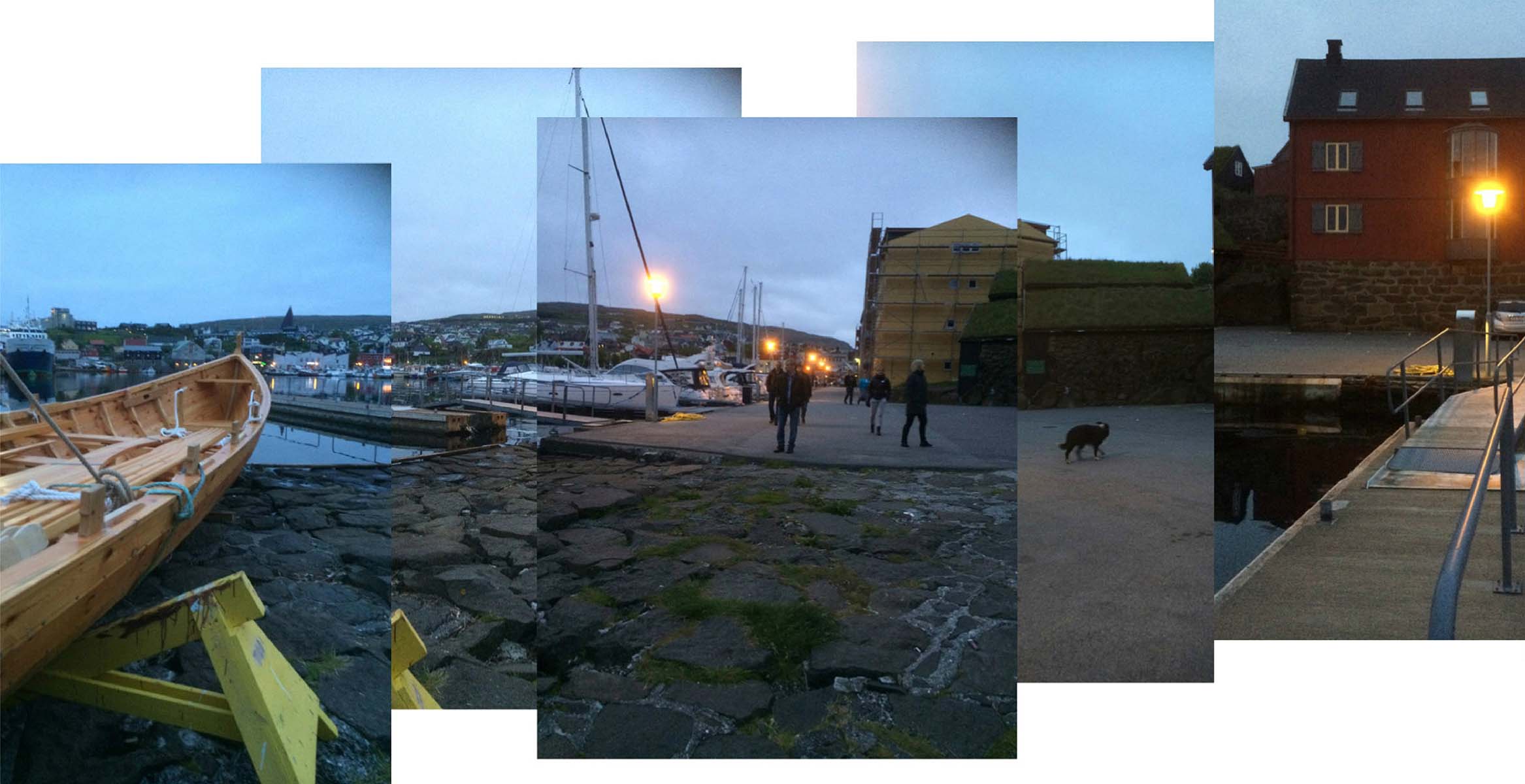
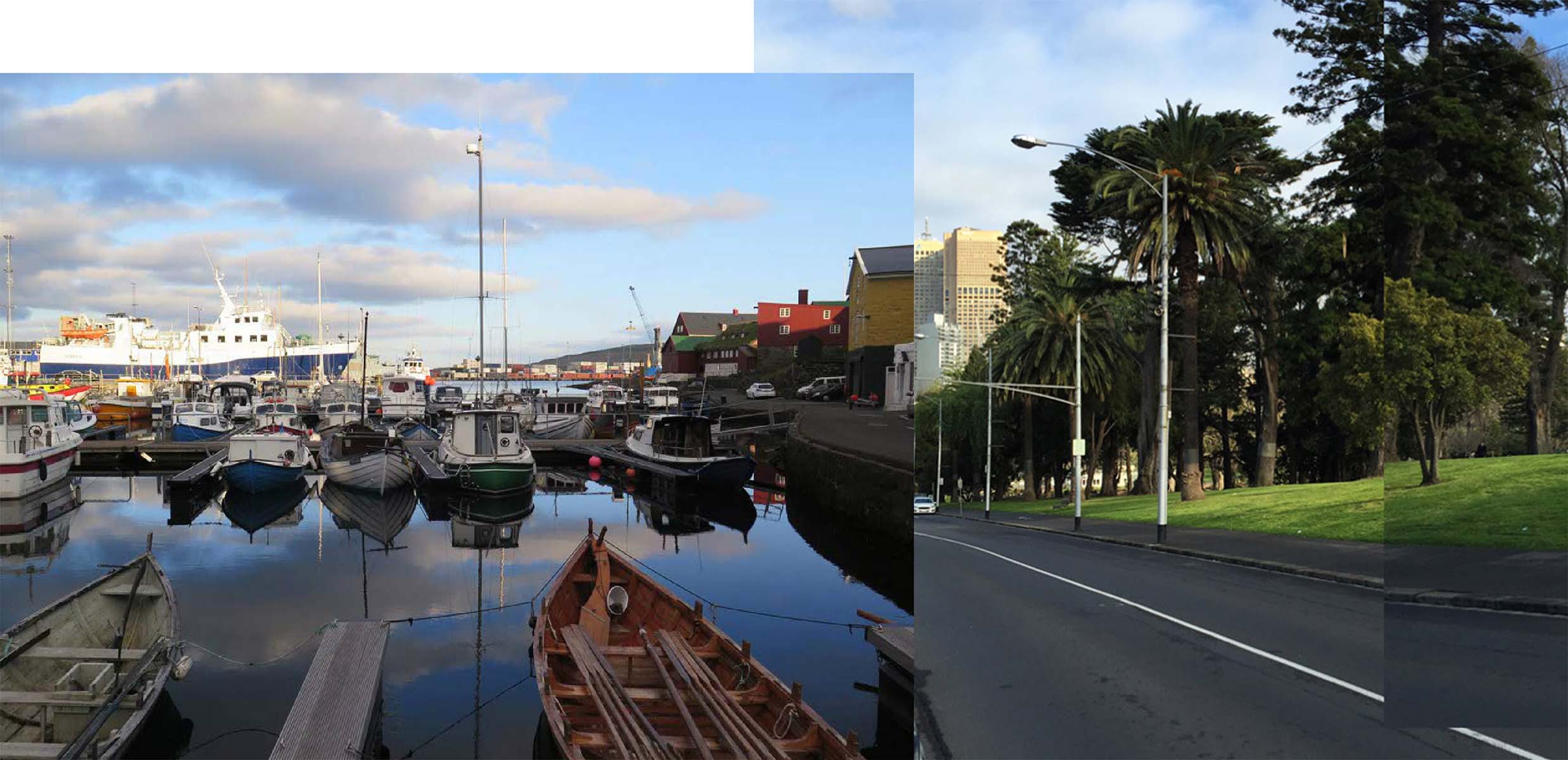
At the Performing Mobilities event in Melbourne, we experienced a different aesthetic emerging. PAN & ZOOM was installed in a public exhibition in the heart of the city, attracting an average of fifty visitors a day during the five-week exhibition. In addition to PSi participants at the Fluid States event, the image collection for PAN came from a range of gallery visitors, tourists, and the general public. The majority of the panoramic images that were collected during the Melbourne exhibition were more touristic in their composition and content. Perfectly framed urban landscapes with clear, straight, horizontal horizon lines, picturesque gardens, cityscapes, and the docklands area were common subjects. Interestingly, most of the photographs were taken using the “panorama” feature built into smartphones, rather than an ad-hoc collage of a sequence of photographs. There was little experimentation with the media technologies from participants, with most preferring to use the pre-built panoramic function as opposed to extracting stills from videos, taking longer sequences or blurring the photographs to capture longer performances or movements as had been played with in the Fluid States North collection.
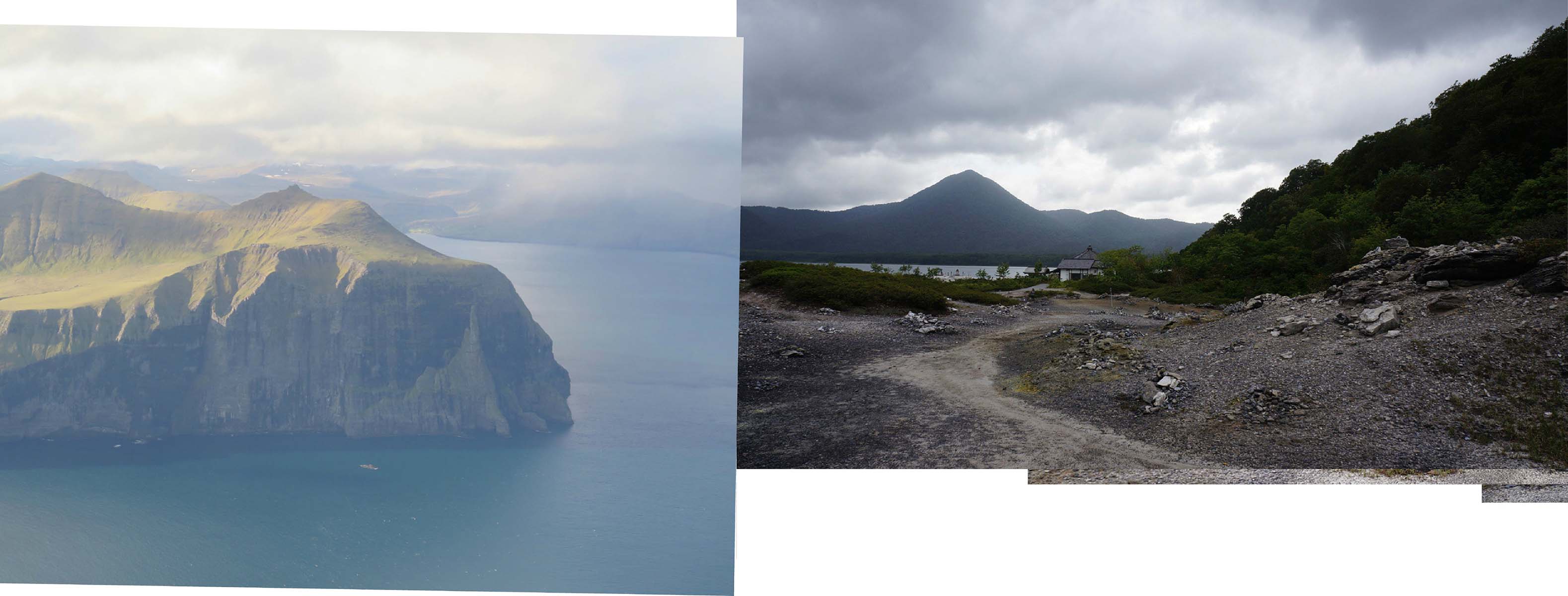
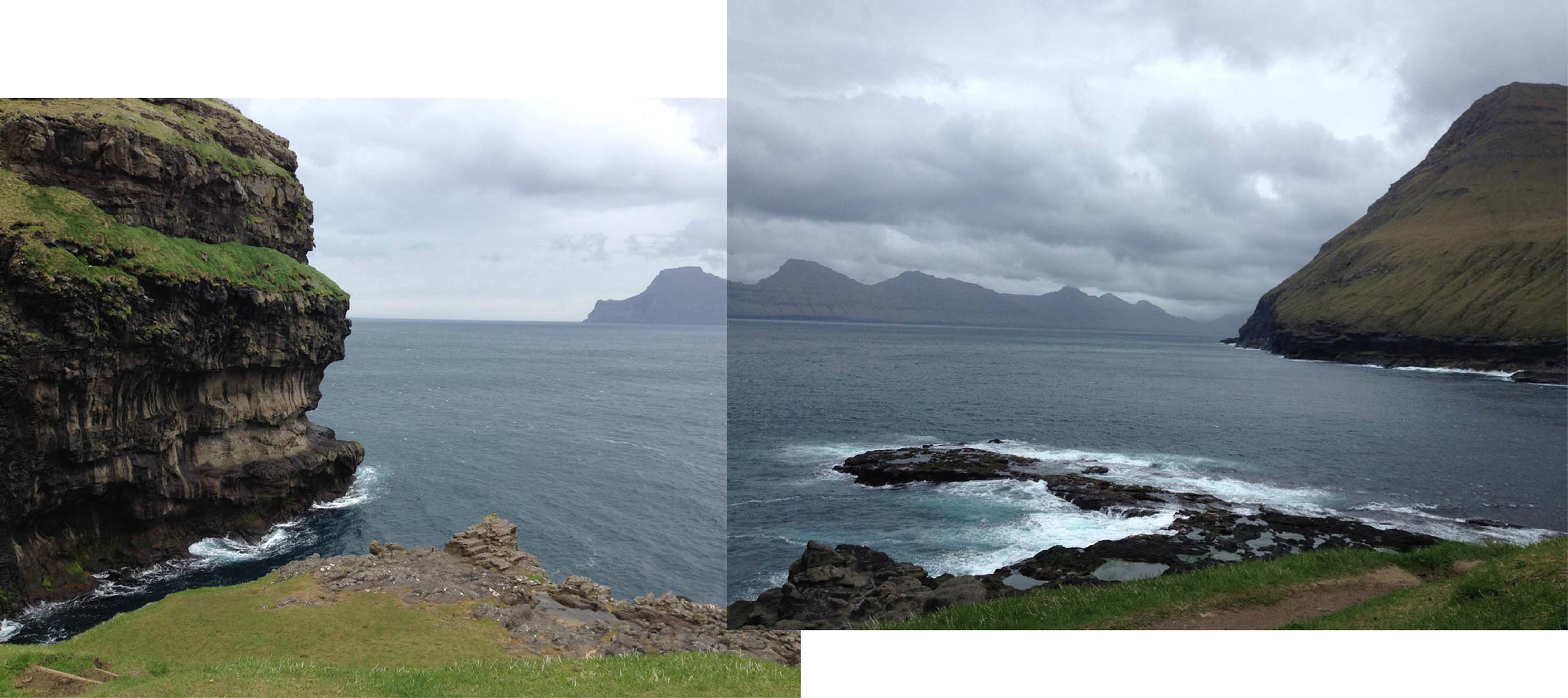


In addition, the feedback that we received when people were moving the interactive panorama in the gallery was that the images of the landscapes did not always align correctly. Often, people were preoccupied with the disconnect between images and places, wondering why an image of Japan’s mountain ranges would be positioned up against an urban streetscape of Melbourne. The feedback and comments that we received tended to focus on the touristic elements, the vast or distant landscape imagery, or the lack of spatio-geographical accuracy of the sequences (see Figures 9 and 10); rather than the more mundane, everyday, or localised documentation of each place (see Figures 11 and 12). The contrasts between the ordinary, everyday experience of place versus the more touristic landscapes were surprising and unexpected.
ZOOM and the lens effect of zooming also concerns a panoramic movement — in and out — rather than across. However, the installation ZOOM, in tandem with PAN, also set out a number of elements that might be considered an inverse panorama. In many ways, the impulse towards the panoramic is an impulse towards 360-degree-ness, that can be characterised as a spreading out; or as an enveloping, closing in, or enclosing. ZOOM provides a contrasting set of spatial experiences, drawing upon lens-based techniques in cinema and photography, and combining the experience of cinematic techniques with the spatial experience of live performative actions.
The main camera effect to which ZOOM makes reference is the “dolly zoom” or the “Hitchcock zoom” made famous and used for the first time in the film Vertigo (1958). This effect is incorporated into the very structure of the installation. The spatial experience of moving image produced by the dolly effect is one of space expanding or dilating around the central figure as though the infinite space between things were being opened up for viewers to perceive. In ZOOM, the wall is moving instead of the camera. The disambiguation of the two movements of the camera (along the dolly and in the focusing mechanism) means that the participants must “feel” the compression or expansion of space behind them in the installation, while, at the same time, they are able to watch the camera effect via a live feed on the TV screen in front of them. In this scenario, two different sets of sensory and conceptual inputs are combined to inform or inflect the experience of space constructed in ZOOM. The spatial experience in ZOOM consists of a dilation of one moment of the panoramic display in PAN. The image on the moving wall is one image in the unending panorama that visitor would see in PAN (see Figure 13). This intersection of PAN and ZOOM, through this one moment/image, allows for a sharp contrast between an experience of an unending horizon that sutures space and compresses time, and a slice of space that dilates space and offers distributed vantage points from which to intensify the sensation of space.
PAN spreads out space and time at varying speeds, enabling the participant to control the speed of the dolly track on which the projector is mounted, as well as the track pad that controls the scrolling speed of the panoramic images. This structure places the viewer-participant parallel to the scrolling image where every step or swipe of the finger allows one to have a constant relation to the horizon. The intersection of ZOOM at one point of the panoramic images creates a bubble (the installation perpendicular to PAN on the other wide of a dividing wall — see Figure 1) and emphasises a varying or constantly modulating relationship with the construction of space. The horizon is not visible and the wall on which a horizon might appear is moving. The constant relation to a spatial point is replaced by a set of viewing positons that extend from and fold back onto the body and viewing positon of the participant in ZOOM. This physical structure inverts the panoramic experience, placing the participant at the centre and at the periphery of the enclosed and well-defined limits of the constructed space.
There are two lens-based techniques in particular, which are not used in the structure of ZOOM and are not directly referenced, but inform the conceptual structure of the installation experience and offer a way to understand the way the installation was devised. The two techniques or effects both use is a multi-camera setup. The first is the famous use of multi-cameras by Eadweard Muybridge in the late 1800s, that slows time and allows the mechanics of motion too fast for human vision to be captured and perceived. This dilation and attenuation reveals what happens in a given span of space. Muybridge’s work paved the way for the development of the multi-camera capture technique popular in the late 1990s and often deployed in action movies and car advertisements. Perhaps the most notable use of the multi camera technique was the “Bullet Time” effect in the film The Matrix. The shot requires many cameras positioned around an action-event, and all capture simultaneously or in short succession, the image usually of a person or animal in action. The images from the individual still-cameras would be stitched and composited together, wrapping spatially around the action, suspending the subject in mid-air.
The multi-camera effect uses a photographic technique in cinema to stop time and seemingly/seamlessly alter the viewers position in space. The experience of this technical setup suspends the form-in-action, producing an attenuation of space and time. The flow of time is halted and replaced with the illusory movement of the camera (or Point Of View), enclosing the event in a spatial bubble, that was previously not perceivable. The compression of time and space through the multi-camera capture and composition enables “an instant to be expanded and contracted at will” (Clarke and Doel 42). Whether in the movie The Matrix or in a car advertisement, the suspension of narrative time is augmented by the time it takes to move around the suspended object or person. When the flow of activity resumes, the speed of events feels all the more intense as a result of the suspense of the action. The seamless continuity that the multi-camera effect produces, making viewers feel as though they have moved in space, is a post-production effect of digital integration of the sequence of images. The construction of ZOOM seeks to disrupt such seamless continuity of time and space by means of inverse panoramas that move inwards and outwards, expanding and contracting to intensify the movements that are on our horizons and in our peripheries.
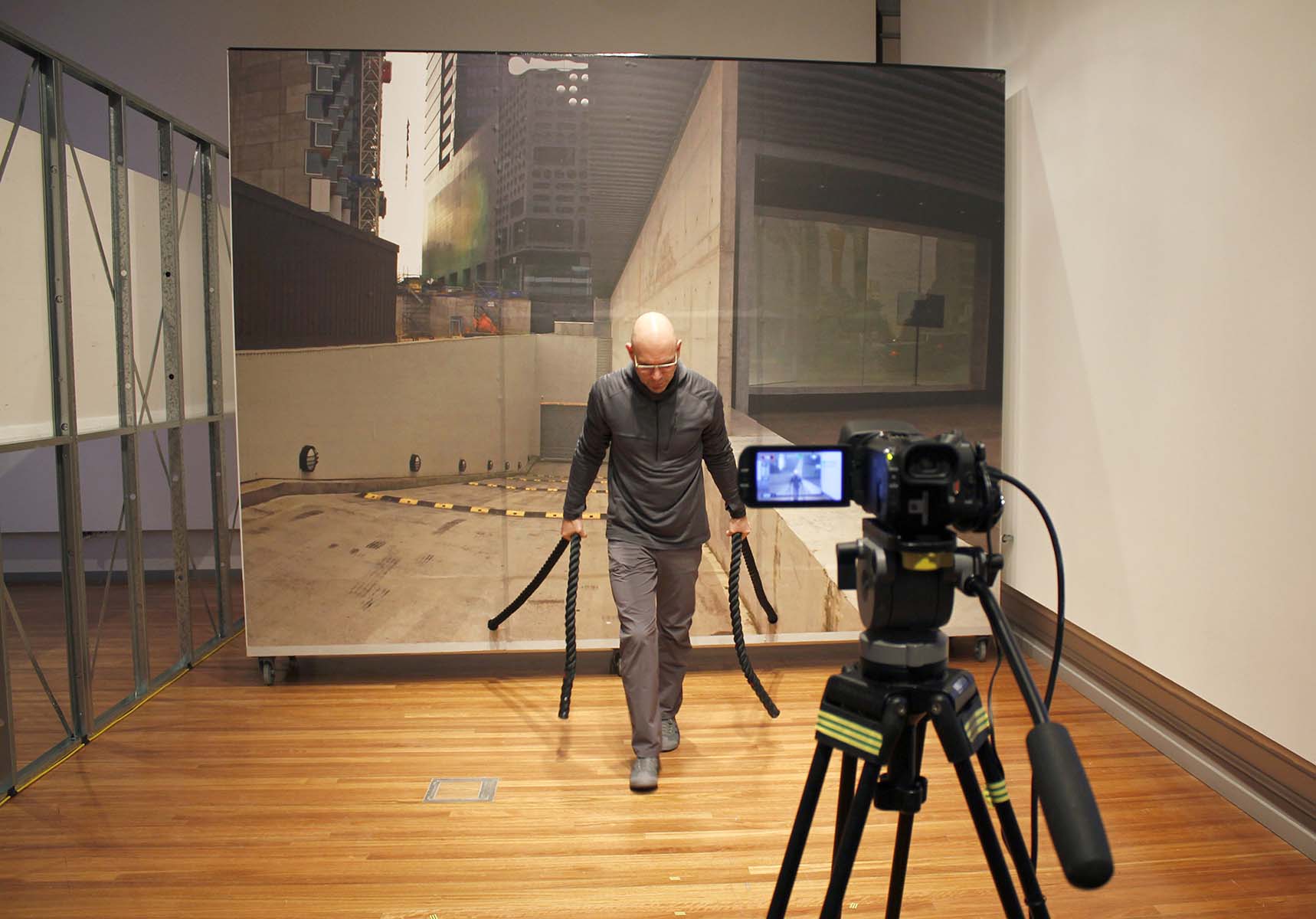
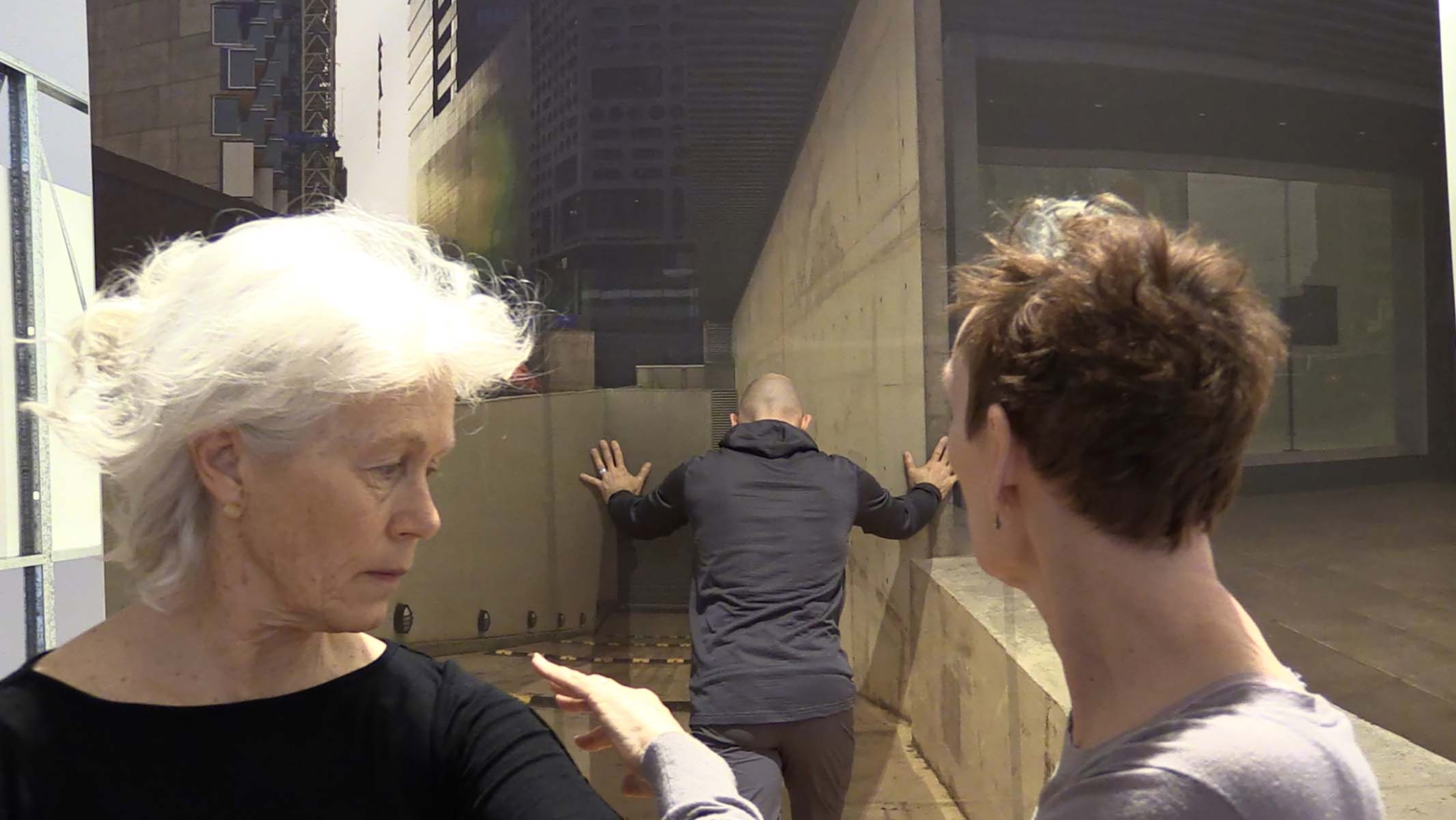
The inverse panorama is one in which the viewer now occupies the positons on the horizon, at the periphery of the environment. Instead of producing the continuity of images that seamlessly erases the apparatus of perceiving and moving, the different elements of ZOOM accentuate the range of techniques, technologies, and modalities of experience involved. Instead of a unified visual field surrounding an object in time, ZOOM offers numerous experiential aids placed in close proximity, as to connect and inflect each other. These include a historical compilation of the zoom effect in cinema; a large plasma screen for live feed of the video in progress; the camera and camera operator directly in front of the participant; the faces of onlookers, friends, and gallery assistants; and a moving wall directly behind the participant operated by the artist. They produce a surround of heterogeneous elements that envelope the participant with tools to enhance, augment, amplify, and reflect upon their experience of space and, more importantly, their active role in the construction of spatiality. This, of course, is also a co-construction, collectively influenced and devised by the accumulated experience that comes in the form of memories, visual culture, live feedback, and reflective technology (in this case the video live feed).
PAN & ZOOM merge individual experiences of movement into an accumulating event where the panorama is no longer a static photographic image, but a practice or collection of practices that traverse places, technologies, experiences, and movements. PAN mobilises and expands the panoramic aesthetic in several ways: through the physical movements of the installed artwork apparatus, the digital movements of the images, and the mobilisation forged through an array of photographs of landmarks, places, and actions from around the world. The artwork, devised as a platform for participatory performance, is adaptive to socio-cultural references (particularly from photographic and cinematic cultures and techniques) and constantly mediates technological-bodily assemblages that are re-positioned to accumulate locations, sensations, and perceptions in one expansive panoramic event. Participants in ZOOM, on the other hand, become co-creates of inverse panoramas that move inwards and outwards, expanding and contracting to intensify the movements that are on our horizons and in our peripheries. When brought back into relationship with PAN, either sequentially in time when participants move from one to the other installation, or spatially, as the modes of movement and the technologies begin to resonate across and within each other, the installation skews the perception of the participants’ surroundings as the entire installation moves and flexes. The interactions between various mobilities (visual, bodily, technological, and mediated imagery) that are set in motion expand and contract the sense of self, other, and location.
With mobile media practices saturating our daily explorations and activities, a contemporary panoramic aesthetic can be found in countless examples of marketing, gadgets, and social media platforms. These applications move individuals beyond their singular perspectives and extend bodies in almost prosthetic ways (Pazzini), as they document themselves and surroundings. This increasing trend to capture oneself within the surrounding environment — in a wide angled, panoramic format — has perpetuated a panoramic aesthetic that has bled into everyday mobile media practices. Our artwork has picked up on these tendencies, examining how the panoramic aesthetic might be indicative of a “panoramic practice.” These practices can re-arrange, re-position, and even unsettle and assemble new and playful uses of space, time, and movement, and feed individual movements into assemblages of collective actions (see Figures 15 and 16).

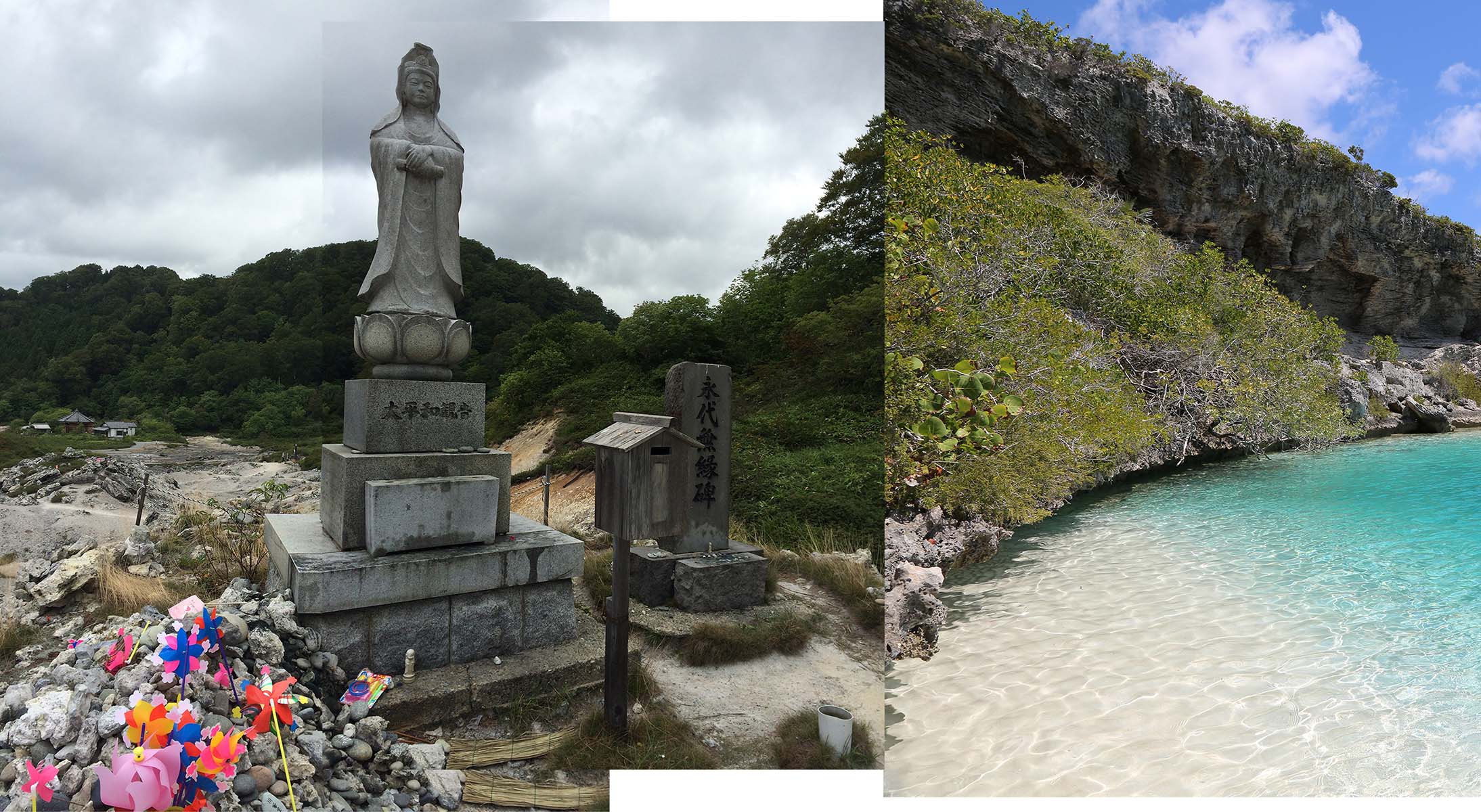
Our collaborative artwork mobilises photographic and cinematic techniques and activates them through technological-bodily performances. It expands and explores singular-collective movements that traverse location, representation, and form. Describing a freeze frame in cinema, Laura Mulvey suggests that, “In their stillness, the repeated images belong to the photograph, to the moment of registration, but in their sequence they signify poignantly the indivisibility of these individual moments from a larger whole, an integral part of the shift into movement” (15). Mulvey’s comments resonate with the to-ing and fro-ing movements of PAN & ZOOM: the individual images assemble into “a larger whole” (Mulvey 15), while the interaction from those performing with the artwork push and pull the panoramic sequence into movement or momentary stillness. This composition stretches beyond (or pans between) global and local places, forming and re-forming experience. Individual and collective perspectives are merged to curve and alter our perspectives, circling the horizon around us as we allow ourselves to move within the expanding panorama.
[1] PAN & ZOOM was installed in the Performing Mobilities curated exhibition at RMIT Gallery, Melbourne, Australia, 24 September-26 October 2015. PAN was shown at the Fluid States North event in Copenhagen, Denmark, in June 2015; and re-created in an alternative installed configuration for the Performing Climates conference in Melbourne, Australia, in June 2016.
[2] In 2015 we collected over 350 photographs from participants, that were either emailed to us, taken in the gallery, or taken with us at the Fluid States events in Copenhagen and Melbourne. In 2016 an additional 170 photographs were collected and used in another version of PAN shown at the Performing Climates in Melbourne.
[3] NASA’s Curiosity has a wealth of image content available and updates regularly to its own social media pages. Notable are the “Deep Zoom Images” (see: http://mars.jpl.nasa.gov/msl/multimedia/deepzoom/) and an example of Curiosity’s “selfie” (see: https://www.nasa.gov/jpl/msl/pia19142).
Barry, Kaya, and Jondi Keane. “Moving Within Mobilities: Expanding spatial experiences through the artwork PAN & ZOOM.” Applied Mobilities, vol. 2, no. 1, 2017, pp. 67-84.
Barry, Kaya. “Transiting with the environment: an exploration of tourist re-orientations as collaborative practice.” Journal of Consumer Culture, vol. 16, no. 2, 2016, pp. 374-392. https://doi.org/10.1177/1469540516635406
Clarke, David B, and Marcus A. Doel. “Engineering space and time: moving pictures and motionless trips.” Journal of Historical Geography, vol. 31, 2005, pp. 41-60. https://doi.org/10.1016/j.jhg.2003.08.022
Haldrup, Michael, and Jonas Larsen. Tourism, Performance, and the Everyday: Consuming the Orient. Oxon & New York: Routledge, 2010.
Huhtamo, Erkki. Illusions in Motion: A Media Archaeology of the Moving Panorama and Related Spectacles. Cambridge, MA: The MIT Press, 2013.
Lindquist, Stephanie. Panoramic Queensland: Exhibition Catalogue. Brisbane: State Library of Queensland, 2009. http://www.slq.qld.gov.au/__data/assets/pdf_file/0007/133783/SLQ_Panoramic_Queensland.pdf Accessed 13 December 2016.
Mcleod, Gary, Tim Hossler, Mikko Itälahti, and Tyrone Martinsson. “Rephotographic Powers: Revisiting Rephotography at Photomedia 2014.” Photographic Powers – Helsinki Photomedia 2014, edited by Mika Elo and Marko Karo, Aalto: Aalto University, 2015, pp. 45-83. http://helsinkiphotomedia.aalto.fi/files/Photographic_Powers_Helsinki_Photomedia2014.pdf Accessed 16 December 2016.
Mulvey, Laura. Death 24x a Second. London: Reaktion, 2006.
Pazzini, Karl-Josef. “Media, suggestion, suspicion.” (e)Pedagogy — Visual Knowledge Building: Rethinking Art and New Media in Education, Edited by Stefan Sonvilla-Weiss, New York: Peter Lang, 2005, pp. 157-180.
The Matrix. Directed by The Wachowski Brothers, DVD, Warner Brothers, 1999.
Urry, John, and Jonas Larsen. The Tourist Gaze 3.0. London: SAGE Publication Ltd, 2011.
Vertigo. Directed by Alfred Hitchcock. 1958. Fox Classics, DVD, 2010.